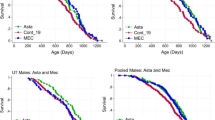Abstract
Livers from mature female rats exposed for up to 36 weeks to dietary levels of Aroclor® 1242 (75 or 150 ppm) and/or commercial grade DDT (75 or 150 ppm) were compared to those from animals receiving basal diets. In earlier studies, reproductive effects of the test substances were assessed. Moreover, the markedly abnormal gross appearance of the livers led to examination of the hepatic effects of PCB and DDT in more detail, at both the light microscope (LM) and electron microscope (EM) levels.
Light microscopy revealed focal liver cell necrosis in rats fed PCB, DDT, and PCB-DDT combinations. Higher levels of PCB (150 ppm) increased the severity of necrosis. Feeding both DDT and PCB produced similar effects at 75 ppm, and caused atypical centrolobular regeneration, occasionally forming nodules resembling small tumors. The experimentally induced injury was associated with the marked accumulation of iron-containing pigment in hepatocytes and Kupffer cells.
Electron micrographs demonstrated the presence of whorl structures (myelin figures) within liver cell cytoplasm, and for the first time clearly illustrated the endocytotic expulsion of these membranous whorls from hepatocytes into the bile canaliculi and sinusoids. Other ultrastructural changes were similar to those previously reported in rat livers injured by several hepatotoxic substances. Mitochondria enclosed by or projecting into large non-lipid vacuoles were present in several experimental groups.
The electron micrographs provide the most convincing evidence to date to support the hypothesis that myelin figures may be the vehicle whereby the cell rids itself of specific hepatotoxic substances.
Similar content being viewed by others
References
Allen, J. R., and L. J. Abrahamson: Morphological and biochemical changes in the liver of rats fed polychlorinated biphenyls. Arch. Environ. Contam. Toxicol.1, 265 (1973).
Allen, J. R., L. A. Carstens, and L. J. Abrahamson: Responses of rats exposed to polychlorinated biphenyls for fifty-two weeks I. Comparison of tissue levels of PCB and biological changes. Arch. Environ. Contam. Toxicol.4, 404 (1976).
Allen, J. R., L. A. Carstens, and D. A. Brasotti: Residual effects of short term, low-level exposure of nonhuman primates to polychlorinated biphenyls. Toxicol. Appl. Pharmacol.30, 440 (1974).
Armour, J. A., and J. A. Burke: Method for separating polychlorinated biphenyls from DDT and its analogs. J. Ass. Offic. Anal. Chem.53, 761 (1970).
Bennett, G. A., C. K. Drinker, and M. F. Warren: Morphological changes in the livers of rats resulting from exposure to certain chlorinated hydrocarbons. J. Ind. Hyg. Toxicol.20, 97 (1938).
Bruckner, J. V., K. L. Khanna, and H. H. Cornish: Effect of prolonged ingestion of polychlorinated biphenyls on the rat. Food Cosmet. Toxicol.12, 323 (1974).
Crosby, D. C., and K. W. Moilanen: Photodecomposition of chlorinated biphenyls and dibenzofurans. Bull. Environ. Contam. and Toxicol.10, 372 (1973).
Greene, W. B., E. M. Walker, Jr., R. H. Gadsden, C. J. Klobukowski, G. R. Gale, and G. R. Hennigar: PCB-DDT toxicity on mouse liver cells: An electron microscopic study. In W. B. Deichmann (ed.): Pesticides in the environment, p. 137. New York: Intercontinental Book Corp. (1973).
Hennigar, G. R., W. B. Greene, E. M. Walker, and C. de Saussure. Hemachromatosis caused by excessive vitamin iron intake. Amer. J. Pathol.96, 611 (1979).
Jonsson, Jr., H. T., J. E. Keil, R. E. Gaddy, C. B. Loadholt, G. R. Hennigar, and E. M. Walker, Jr.: Prolonged ingestion of commercial DDT and PCB: effects on progesterone levels and reproduction in the mature female rat. Arch. Environ. Contam. Toxicol.3, 479, (1975–76).
Kimbrough, R. D., R. E. Linder, and T. B. Gaines: Morphological changes in livers of rats fed polychlorinated biphenyls. Arch. Environ. Health25, 354 (1972).
Kimbrough, R. D.: Pancreatic-type tissue in livers of rats fed polychlorinated biphenyls. J. Natl. Cancer Inst.51, 679 (1973).
Kimbrough, R. D., R. A. Squire, R. E. Linder, J. D. Strandberg, R. J. Montali, and V. W. Burse: Induction of liver tumors in Sherman strain female rats by polychlorinated biphenyls Aroclor 1260. J. Natl. Cancer Inst.55, 1453 (1975).
Kuratsune, M., T. Yshimura, J. Matsuzaka, and A. Yumaguchi: Epidemiologic study of Yusho, a poisoning caused by ingestion of rice oil contaminated with a commercial brand of polychlorinated biphenyls. Environ. Health Persp.1, 119 (1972).
McKeever, P., and J. D. Balentine: An ultrastructural study of acid phosphatase activity of rat ventral motor horn cells with observations on the effects of hyperbaric oxygen. Lab. Invest.29, 633 (1973).
McNulty, W. P., and D. A. Griffin: Possible polychlorinated biphenyl poisoning in rhesus monkeys (Macaca mulatta). J. Med. Primatol.5, 237 (1976).
Maugh, T. H., II: DDT, an unrecognized source of polychlorinated biphenyls. Science180, 578 (1973).
Miller, J. W.: Pathological changes in animals exposed to commercial chlorinated diphenyl. Public Health Rep.59, 1,085 (1944).
Moilanen, K. W. and D. G. Crosby: 165th. Meeting, Amer. Chem. Soc., Dallas, TX, April 10, 1973.
Nishizumi, M.: Light and electron microscopic study of chlorobiphenyl poisoning in mouse and monkey liver. Arch. Environ. Health21, 620 (1970).
Ortega, P.: Light and electron microscopy of DDT poisoning in rat liver. Lab Invest15, 667 (1966).
—: Partial hepatectomy in rats fed DDT. Amer. J. Path.56, 229 (1969).
Smith, R. J.: (Editorial) Worse news about PCBs. Science206, 35 (1979).
Terracini, B., M. C. Testa, J. R. Cabrai, and N. Day: The effects of long-term feeding of DDT to BALB/c mice. J. Cancer11, 747 (1973).
Tomatis, L., V. Turusov, N. Day, and R. T. Charles: The effect of long-term exposure to DDT on CF-1 mice. J. Cancer10, 489 (1972).
Trump, B. F., and A. U. Arstella: Cellular reaction to injury. In M. F. LaLia and R. B. Hill, Jr (eds.): Principles of pathology, p. 9. New York: Oxford Univ. Press, (1977).
Zinkl, J. G.: Skin and liver lesions in rats fed a polychlorinated biphenyl mixture. Arch. Environ. Contam. Toxicol.5, 217 (1977).
Author information
Authors and Affiliations
Rights and permissions
About this article
Cite this article
Jonsson, H.T., Walker, E.M., Greene, W.B. et al. Effects of prolonged exposure to dietary DDT and PCB on rat liver morphology. Arch. Environ. Contam. Toxicol. 10, 171–183 (1981). https://doi.org/10.1007/BF01055619
Received:
Accepted:
Issue Date:
DOI: https://doi.org/10.1007/BF01055619




